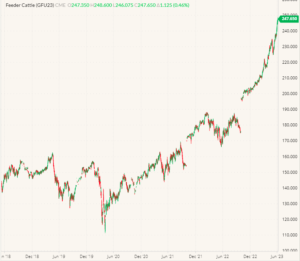The Animal Protein Market: Is There a Risk of Collapse in the U.S.?
John Payne, hEDGEpoint Relationship Manager, clarifies how the animal protein market in the United States is doing, and why it’s at risk of collapsing in that country.
Animal protein commodities are products of animal origin that are traded on international markets as basic homogeneous goods. In addition, they’re widely marketed and have prices that are influenced by several factors, including supply and demand, weather conditions, animal feed, government policies, socio-political conflicts, economic changes, and diseases.
Animal protein includes a variety of products, such as beef, pork, poultry, lamb, fish, dairy products, eggs, and other animal derivatives. These goods are produced on an industrial scale and are subject to specific standards and regulations to ensure food safety and quality.
Currently, it’s a sector characterized by a complex, challenging world context. The COVID-19 pandemic, for example, significantly impacted supply and demand, as well as prices. One of the countries most affected by that scenario was the U.S.
In this article, you’ll understand more about the beef and pork scenario in the North American nation, and why there’s the risk of collapse, highlighting again the importance of risk management.
Beef faces reduced production in the U.S.
John Payne, hEDGEpoint Relationship Manager in the U.S., explains the main challenge of the country’s beef market: “We’re at a point where there aren’t many animals available in the short term. The supply of cattle has been decimated in the last five years because of unprofitable farms, COVID-19, and extreme drought. Farmers are now being encouraged to increase herds, but it’s a long process with varying costs,” Payne explains.
After the pandemic, demand increased again, but the beef production cycle takes time and typically doesn’t keep pace with consumption. Just to give you an idea: the herd of beef cows in the country has dropped to its lowest level since 1962, according to data from the United States Department of Agriculture (USDA).
One of the reasons for this drastic reduction was the extreme drought suffered by the U.S. in 2022. As a result, animal feed costs rose, as adverse weather reduced the amount of available pasture. Thus, ranchers sent fewer and fewer cows to slaughter, instead of keeping them to breed.
Another relevant issue is the amount of hay available. A sizable portion of the U.S. cattle herd still faces the effects of drought, even though conditions have improved. This has resulted in hay shortages, with May 1 stocks down 13% from 2022, the lowest level in a decade.
Hence, the reduced supply of hay may not be enough to compensate for poor pastures and may not sustain herds in the North American summer, in turn affecting reproduction. Due to this, the USDA states that the slaughter of beef cows will continue at a relatively high rate.
As a result, Payne forecasts a significant rise in this commodity’s prices due to the low market supply, as we can see in the graph below:

Given these factors, the USDA estimates that world beef production should decrease by 0.2% in 2023. The drop is mainly due to the cuts in production in the U.S.: the country should total 12.01 million tons, an amount that’s 6.3% lower than in 2022. The projections of Dutch bank Rabobank indicate that beef production in the U.S. should decrease from 400 to 500 thousand tons per year until 2026.
Pork: Domestic demand lower than supply
In the U.S. pork market, domestic demand is slower this year. Inflation continues to reduce the population’s purchasing power and slow down the economy. The USDA points out that U.S. commercial production is forecast to be 1.4% higher in 2023, totaling around 12.4 million tons, with a gradual increase in hog harvests along with higher weights.
This situation contributes to a greater supply of pork in relation to domestic consumption. Therefore, prices have been reduced and represent an extremely attractive value for large importers, such as China and Mexico. The USDA forecasts slightly higher exports to Japan and South Korea as well, due to the country’s increased competitiveness versus the European Union. Above all, the growth is due to greater demand from these Asian countries, as consumption is recovering towards pre-pandemic levels.
Another important aspect that could further increase U.S. export volumes is a new outbreak of African Swine Fever (ASF) in China, the main exporter and importer of pork on the planet. Disruptions in Chinese supply chains should lead to the reorganization of global protein markets, as well as possible price increases.
According to hEDGEpoint analysis, in the short term, the market shouldn’t suffer from the PSA problem in China, as supply is high. “What could happen is a trend of increasing imports from China in the long term, in case there’s an outbreak of PSA again,” Payne points out.
The U.S.: Understand why the risk of collapse exists
Given the current scenario for U.S. beef and pork, we’ve identified some key factors that could lead to a collapse:
- The low production of beef
- The imbalance between pork supply and demand
- The possibility of an ASF outbreak
- Climate change in general.
Payne explains that the risk of collapse lies in the logic of the sector’s production chain: “You can’t increase or decrease production quickly. The reproductive process takes longer, especially for beef, and there’s also the need for more feed when reproduction increases.”
In the case of pork, ASF could affect U.S. production in the future. Losses could average $7.5 billion a year, according to Iowa State University economist Dermot Hayes.
This would happen because exports would be lost, and some of the products that could have gone to China would be processed, thus becoming useless or losing a lot of value. But much of the muscle meat would end up on the domestic market, increasing consumption by up to 30%, and causing a huge drop in prices, according to Hayes.
Regarding climate change, FAIR’s Climate Risk Tool indicates that climate-related costs may affect agricultural production, such as higher feed prices and expected carbon taxes. The increase in the price of feed will be responsible for 5% of the cost increases for livestock companies, posing yet another obstacle for industries. The expected carbon taxes on emissions from livestock production will represent 4% of the cost increase.
What’s the importance of risk management?
The animal protein scenario in the U.S. is a case that leaves no doubt: the commodity market is extremely volatile. Economic, political, and climatic changes constantly interfere with production and prices.
Possessing a plan that provides security is vital for agents involved in this global chain. Therefore, using risk management strategies is essential. With hedging products, expert knowledge, and market intelligence analysis, hEDGEpoint offers you all the support for the best futures trading experience possible.







